BRITISH COLUMBIA
History

History
Popular destinations CANADA
| Alberta | British columbia | Manitoba |
| New brunswick | Newfoundland and labrador | Northwest territories |
| Nova scotia | Nunavut | Ontario |
| Prince edward island | Quebec | Saskatchwan |
| Yukon |
History
British Columbia before the arrival of the Europeans
Between 20,000 and 15,000 years ago, the first ancestors of the 'First Nations' of British Columbia showed themselves in mainland North America and particularly in present-day British Columbia. At that time, North America and Asia were not yet separated by the Bering Strait, but there was still a land bridge between Russia and Alaska. From 10,000 BC, after the retreat of the great glaciers that covered the country at that time, some settled on the Pacific coast, others moved more inland. The return to Asia was also definitively closed due to the rise in sea level.
It is thought that the coastal region of present-day British Columbia soon grew into one of the most densely populated areas in North America, with perhaps more than 300,000 inhabitants. Indigenous culture remained undisturbed for thousands of years, until the arrival of the British in 1778.
The above theory, because there are of course no written sources, has been contested lately. The first humans to arrive in North America, according to new theories based on carbon-14 dating, also arrived by water. The image below shows this well.
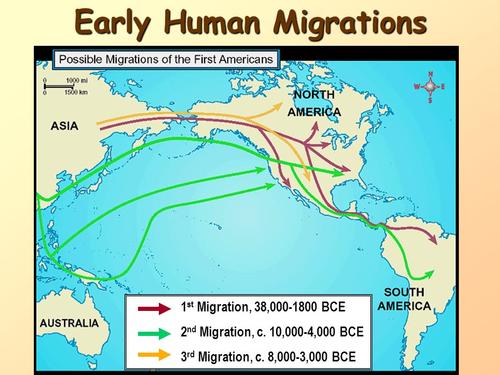 Migration by land and water to North AmericaPhoto: Public domain
Migration by land and water to North AmericaPhoto: Public domain
The first First Nations peoples on the Pacific coast were Nuxalk, Cowichan, Gitksan, Haida, Kwakwaka'wakw, Nisga'a, Nuu-chah-nulth, Salish, Sechelt, and Tsimshian. Due to a relative abundance of food, these peoples were also very active in the artistic field, as witnessed by the beautiful totem poles and masks that have been preserved. In addition to developing their artistic qualities, these coastal inhabitants also managed to build a complex trade network.
In the interior, with harsher climatic conditions, people lived a nomadic life and were happy if they could provide for themselves. In the north of British Columbia, these hunters followed caribou and elk, in the south the bison. Most of the peoples were Atapskan (now called Dene) like Chilcotin, Sekani and Tahltan, Interior Salish and Kootenay.
A great event in the year 800 had a major impact on the peoples of British Columbia. An eruption of the volcano now known as Mount Churchill in Yukon province caused the ash to destroy nature. Many Native Americans left the devastated area and moved to the southwestern United States. These groups later evolved into nations such as the Navajo and the Apaches.
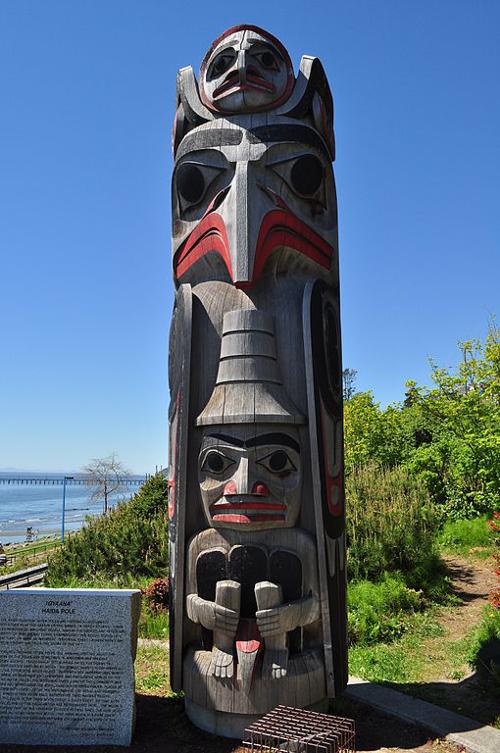 Totem Plaza at Lions Lookout Park, White Rock, British ColumbiaPhoto: Joe Mabel CC 3.0 Unported no changes made
Totem Plaza at Lions Lookout Park, White Rock, British ColumbiaPhoto: Joe Mabel CC 3.0 Unported no changes made
The first Europeans
Around the middle of the 18th century, the first European explorers, in search of new riches, appeared on the west coast of Canada and the United States. It is likely that the Russian Alexei Chirikov (1703-1748) was the first white person to enter British Columbia in 1741, but there is also speculation that the Englishman Sir Francis Drake may have been there as early as 1579. By the way, Chirikov mainly traveled along the Alaskan coast.
In any case, Spaniards followed, who claimed the entire west from Mexico to Vancouver Island. First, Juan Pérez Hernández (ca. 1725-1775) sailed from Mexico in 1774 to the Queen Charlotte Islands off the coast of British Columbia and Nootka Sound on Vancouver Island, followed in 1775 by Francisco de la Bodega y Quadra (1744-1794).
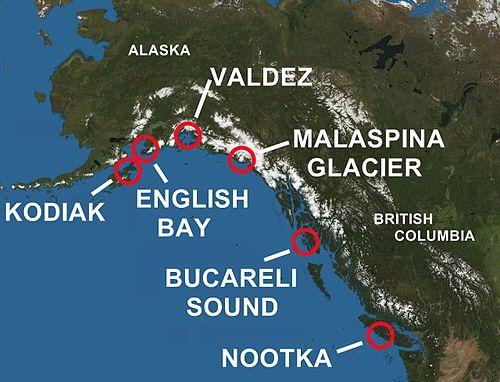 Spanish Expeditions to British Columbia and Alaska, Late 18th CenturyPhoto: NorCalHistory - NASA CC 3.0 Unported no changes made
Spanish Expeditions to British Columbia and Alaska, Late 18th CenturyPhoto: NorCalHistory - NASA CC 3.0 Unported no changes made
In 1778, British Captain James Cook reached British Columbia and his enthusiastic tales of the riches to be gained from the trade in animal skins attracted many adventurers and trappers to the area. The Scotsman Alexander MacKenzie (1764-1820) was one of them, he was the first to cross the entire continent above Mexico, but was stranded near present-day Bella Coola and fled to the east again from Heiltsuk Indians. He just missed the open ocean. Other well-known trappers were the Scotsman Simon Fraser (1776-1862) and the Englishman David Thompson (1770-1857).
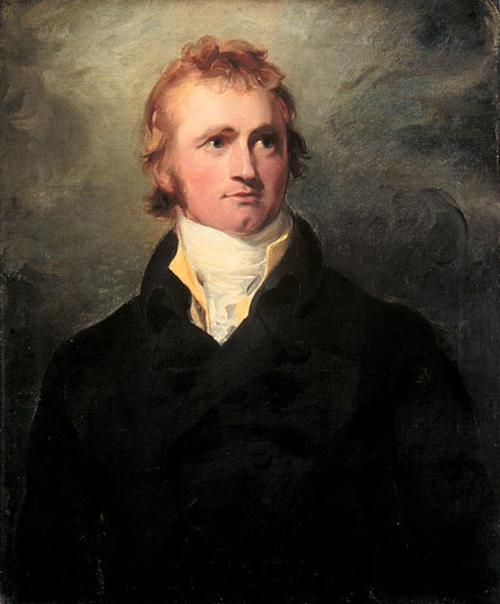 Alexander MacKenzie was the first to cross the North American continent from east to westPhoto: Public domain
Alexander MacKenzie was the first to cross the North American continent from east to westPhoto: Public domain
The first European settlement, Fort St. John on the Peace River, was built in 1794, followed by many others. The Hudson's Bay Company (today still one of the largest department store chains in Canada) soon gained control of all these trading posts.
At the same time, Captain George Vancouver (1757-1798) had been sent to the west coast of North America to fight the presence on what later became Vancouver Island off the coast of British Columbia and to claim Vancouver Island for the British. In 1843, Guyana-born Briton James Douglas (1803-1877) was sent to Vancouver Island and founded Fort Victoria there. In 1849 Vancouver Island became a Crown Colony and in 1849 British and American claims were settled and the boundaries established in the Oregon Treaty. Vancouver Island was assigned to British Columbia.
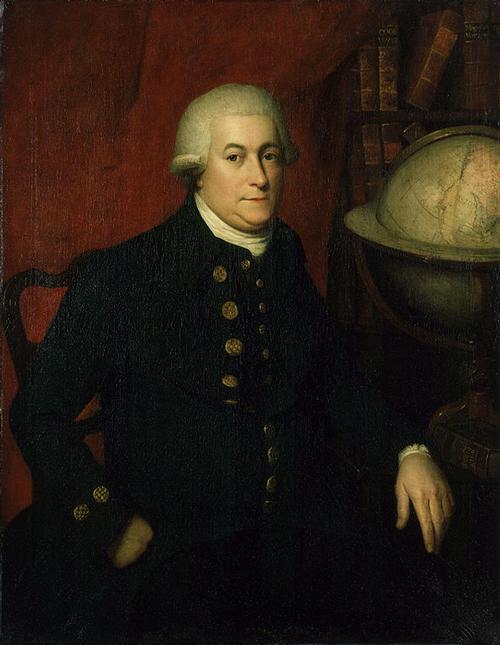
In 1858 gold was found in the Fraser River and many gold and fortune seekers moved to British Columbia, which was immediately proclaimed a crown colony of Great Britain. Later on, north of the Fraser River, in the Cariboo region, gold was also found and that led to a new 'gold rush'. Although the actual 'gold rush' only lasted a few years, many lingered in the region and many settlements were established.
British Columbia and Vancouver Island were merged in 1866 and Victoria was declared the capital in 1868. British Columbia, along with the other states in western Canada, joined the "Dominion of Canada" confederation on July 20, 1871, through the British North American Act of 1867, on the condition that the federal government build a railroad from the east to western Canada. It did, and in 1885 the Canadian Pacific Railway completed this transcontinental railroad, which runs from Montreal to the Pacific coast and transported much timber for the construction of many settlements in western Canada. Although part of Great Britain, much (political) power remained in the hands of the central Canadian government and the individual provinces. The Canadian Confederation was led in those early years by three future Prime Ministers of British Columbia, Amor De Cosmos (1825-1897), Robert Beaven (1836-1920) and John Robson (1824-1892). They pushed British Columbia towards the Canadian Confederation and in 1871 British Columbia became the sixth province to join the confederation. The first Prime Minister of British Columbia was the Irish-born, non-party John Foster McCreight (1827-1913). In October 1871, the first provincial general election was held and McCreight won a seat on behalf of Victoria City. He was subsequently elected as British Columbia's first Prime Minister by then-Lieutenant Governor Joseph Trutch. In the short time he reigned, from November 14, 1871 to December 23, 1872, McCreight's government was prolific, passing more than 35 laws.
John Foster McCreight was succeeded by Mormon journalist Amor De Cosmos (1825-1897; original name William Alexander Smith), who was asked by Lieutenant Governor Joseph Trutch to form a new government as a non-partisan prime minister. He took office on December 23, 1872, and committed himself to political reform, economic expansion, and the development of education in British Columbia. After much criticism on a number of private matters, he resigned on February 9, 1874.
The Cosmos was succeeded on 11 February 1874 by the non-partisan Irish lawyer George Anthony Walkem (1834-1908), who was forced to resign less than two years after a vote of no confidence. He was succeeded on September 11, 1875 by the non-partisan jurist Andrew Charles Elliott (1829-1889) and Walkem became the leader of the opposition in Parliament at the time. Elliott remained prime minister of an unstable cabinet until February 11, 1878, and failed to build a railroad to the Pacific at the federal level. He also did not make himself popular by raising taxes and the construction of a train station for the capital Victoria also did not get off the ground.
Elliott was succeeded on June 25, 1878, after a successful election campaign, by George Anthony Walkem, who had retired from office just over two years ago. The new Walkem government was strongly against hiring any more Chinese workers, and all contracts signed by the government included a clause prohibiting the hiring of Chinese. A special tax for Chinese only was fired by the Canadian Supreme Court.
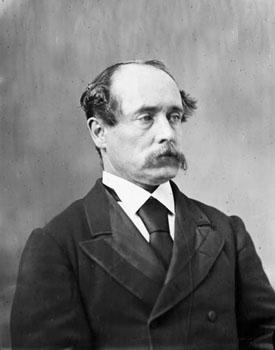 George Anthony Walkem, 3rd and 5th Prime Minister of British ColumbiaPhoto: Public domain
George Anthony Walkem, 3rd and 5th Prime Minister of British ColumbiaPhoto: Public domain
In 1882 Walkem lost the election to businessman Robert Beaven (1836-1920), but he remained prime minister of British Columbia for less than a year. He ruled a minority cabinet from June 13, 1882 to January 29, 1883, and was forced to resign after a vote of no confidence. Beaven later served as opposition leader for several years and was mayor of Victoria for several periods.
Beaven was succeeded on January 29, 1883 by the Englishman William Smithe (1842-1887 and in England William Smith), who had settled on Vancouver Island in 1862 as a farmer. Smithe was an opposition leader throughout his political career and also served in the cabinet of Andrew Charles Elliott. During his term, he ensured that the national government resumed construction of the Canadian Pacific Railway. Smithe died in harness as Prime Minister of British Columbia on March 28, 1887, a fate that also befell his non-partisan successor, attorney Alexander Edmund Batson Davie (1847-1889). Davie was the first person to complete his legal training in British Columbia and became Attorney General under Prime Minister William Smithe, among other things. After Beavan's death, Davie was asked by Canada's Lieutenant General Hugh Nelson (1830-1893) to become Prime Minister of British Columbia. Despite ill health, he took the job on April 1, 1887, but on August 1, 1889, Davie died of tuberculosis.
The ninth Prime Minister of British Columbia would be businessman and journalist John Robson (1824-1892). He was already his replacement during the illness of his predecessor Davie, and after his death the lieutenant governor asked him to form a new cabinet. During his reign from August 3, 1889, he wanted, among other things, to get higher education in British Columbia off the ground. That was only partially successful, when Robson died suddenly on June 29, 1892, there were only three high schools in British Columbia, in Victoria, Nanaimo and Vancouver. The plan for a university failed due to the rivalry between Victoria and Vancouver and the University of British Columbia would not open its doors until 1915. Johnson died tragically, he got a finger stuck in the door of a London taxi and died nine days later from blood poisoning.
Johnson was succeeded on July 2, 1892 by the brother of former Prime Minister Alexander Edmund Batson Davie, the lawyer and jurist Theodore Davie (1852-1898), who had already made it to Attorney General under John Robson. Davie's most notable achievement was the construction of Parliament Buildings in Victoria. Despite his job as Prime Minister of British Columbia, he continued to run his busy law firm, which cost him so much time and energy that his health suffered. On March 2, 1895, Davie resigned as Prime Minister of British Columbia.
The Englishman John Herbert Turner (1833-1918) left for North America in 1856 and would eventually succeed Theodore Davie as the eleventh Prime Minister of British Columbia on March 4, 1895. From 1887 to 1895 he was the Secretary of the Treasury and Agriculture of several cabinets (Alexander Davie, John Robson, Theodore Davie); from 1901 to 1915 he would represent British Columbia in London. During his term of office, Turner immediately came under fire, because during his period as Minister of Finance (1887-1898) there were large deficits every year. He was also accused by opposition newspapers of favoritism, a lax civil service and extravagant spending of public money. After all, he would also have used his public office to enrich himself. In the period leading up to provincial elections in July 1898, Turner increasingly lost public credit. Although the elections ended roughly evenly between government and opposition candidates, Lieutenant General Thomas Robert McInnes (1840-1904) nevertheless pushed for Turner's resignation, which he followed up on August 8, 1898 after some resistance. His resignation brought an end to a political and economic power base established in the capital Victoria. The rise of Vancouver in mainland British Columbia had been unstoppable since the completion of the Canadian Pacific Railway in 1885, and British Columbia's economic center slowly shifted from Victoria to the mainland.
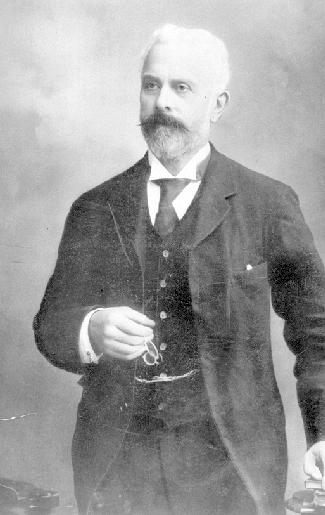 John Herbert Turner, 11th Prime Minister of British ColumbiaPhoto: Public domain
John Herbert Turner, 11th Prime Minister of British ColumbiaPhoto: Public domain
Turner was succeeded on August 15, 1898 by the then opposition leader, schoolteacher, hotel owner and rancher Charles Augustus "Charlie" Semlin (1836-1927), after Lieutenant General McInnes first asked former Prime Minister Robert Beaven. Semlin would remain prime minister for only eighteen months, from August 15, 1898 to February 27, 1900. The turn of the century was a turbulent one due to the informal structures that tried to keep all political groups together. Due to a lack of real leadership, Semlin was unable to handle this well, as well as a clash between two of his cabinet members. Some reform proposals were also not accepted, including a months-long mining strike as a result. Finally, Lieutenant General McInnes fired Semlin's cabinet on February 27, 1900.
As everywhere in Canada and the United States, the original inhabitants suffered from the growing population and economic development. Also in British Columbia they had to leave their original habitat and that was accompanied by a lot of violence. In addition, missionaries complained about the pagan customs of the Native Americans, resulting in a ban on practicing their traditional customs. The 'potlatch' tradition that is so important to them, a system of gifts that always exceed each other, was banned in the eighties of the 19th century and only reinstated in 1951.
In the second half of the 19th century, British Columbia's economy also improved, and the furskin industry was replaced by mainly fishing, forestry and agriculture. These remained the main pillars of the economy well into the 20th century. The economic prosperity also meant that trading posts like Victoria, Nanaimo and Kamloops quickly developed into modern cities. New cities were Yale, New Westminster and, as an afterthought, Vancouver, but that city quickly grew into the most important city in British Columbia. From about 1850 to the end of the 19th century, ethnic diversity also began to show itself more and more, because immigrants, attracted by industrialization and the associated economic growth, came not only from Europe, but especially also from Asian countries such as China and Japan.
The development of the economy was accompanied by the emergence of a militant labor movement. The first major strike was in 1903 by train workers and that cost strike leader Frank Rogers (ca. 1878-1903) his life, he was killed by agents of the Canadian Pacific Railway. The first nationwide strike in Canada also killed a strike leader, in 1918 Ginger Goodwin (1887-1918) died at the Cumberland coal mine on Vancouver Island.
The first years of the 20th century were a coming and going of partyless prime ministers. Charles Augustus Semlin was successively succeeded by Joseph Martin (February 28, 1900 - June 14, 1900, founder of the Vancouver Guardian newspaper and member of the British House of Representatives for eight years), James Dunsmuir (June 15, 1900 - November 21, 1902, from 1906 to 1909, the 8th Lieutenant Governor of British Columbia) and Edward Gawler Prior (November 21, 1902 – June 1, 1903, 11th Lieutenant Governor of British Columbia).
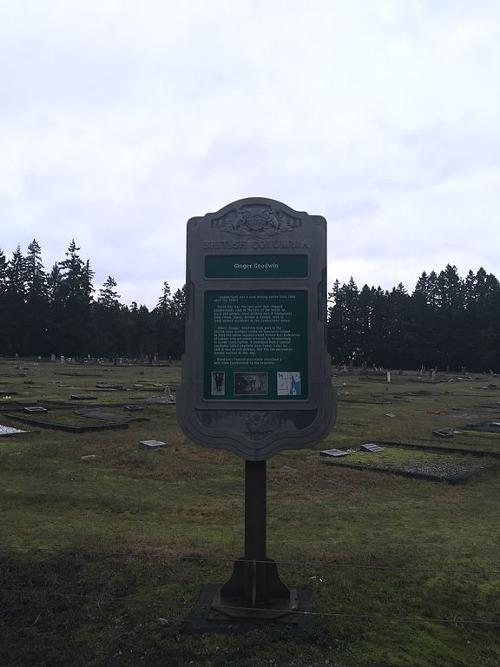 Ginger Goodwin Memorial at Cumberland Cemetery, British ColumbiaPhoto: Richard Eriksson CC 2.0 Generic no changes made
Ginger Goodwin Memorial at Cumberland Cemetery, British ColumbiaPhoto: Richard Eriksson CC 2.0 Generic no changes made
British Columbia's 16th Prime Minister was Richard McBride (1870-1917), who ruled from June 1, 1903 to December 15, 1915, and is considered the founder of the British Columbia Conservative Party. His party won British Columbia's first election conducted along party lines with a two-seat majority. The elections in 1909 and 1912 were won with a larger majority. Under his rule, British Columbia's first university, the University of British Columbia, was opened in 1915. After his term in office, he represented his county in London for a few more years. The completion of the Panama Canal in 1914 made it easier for British Columbia to transport timber to the North American east coast and Europe. The interior of British Columbia benefited greatly from the completion of the Grand Trunk Railway from Edmonton, Alberta to Prince Rupert. Like later in the United States, the prohibition of alcohol, the 'Prohibition', created an extensive black market between 1917 and 1921.
McBride was succeeded by the conservative William John Bowser (1867-1933), who remained in power for less than a year and was succeeded after the lost elections in 1916 by the Liberal party leader Harlan Carey Brewster (1870-1918), who unexpectedly resigned in 1918. died at the age of 47 and had only been in power for a year and a half. Carey Brewster was succeeded by his Minister of Agriculture and Railways, John Oliver (1856-1927), who ruled British Columbia from March 3, 1918 until his death on August 17, 1927. The 20th Prime Minister of British Columbia was John Duncan MacLean (1873-1948) ), under Prime Minister John Oliver, he was still Minister of Finance. Under his rule, the Liberal Party experienced a decline and this was confirmed in the 1928 elections, which were won by the conservatives of Simon Fraser Tolmie (1867-1937).
Tolmie reigned from 1928 to November 1933, in the midst of the Great Depression with its mass unemployment in the early 1930s; British Columbia suffered the most with an unemployment rate of 28%, the highest rate in all of Canada. The strikes and demonstrations at that time were mainly led by the Communist Party, peaking in 1935, during the reign of Thomas Dufferin Pattulo (1873-1956), who had succeeded Tolmie after a very convincing election victory with 34 of the 47 seats in the parliament. parliament. The outgoing Tolmie government was also British Columbia's last all-conservative government for the time being. After two months of continuous unrest, some 2,000 unemployed people decided to travel to the capital Ottawa, a journey that became known as the "On-to-Ottawa Trek" and led by Arthur "Slim" Evans (1890-1944).
However, the protesters got no further than Regina in the province of Saskatchewan, and the fighting between them and the Royal Canadian Mounted Police, among others, left two policeman Charles Millar and the Tractor Nick Shaack dead. Hundreds were also injured and more than a hundred Trekkers and civilians were arrested by police equipped with revolvers and machine guns.
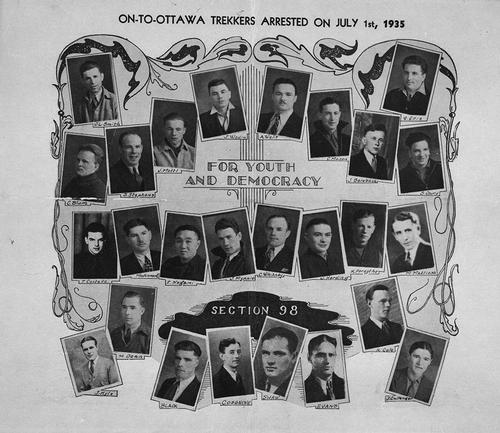 Arrested 'trekkers' from the On-to-Ottawa Trek'Photo: Communist Party of Canada in the public domain
Arrested 'trekkers' from the On-to-Ottawa Trek'Photo: Communist Party of Canada in the public domain
Pattullo remained in power after the 1937 elections, but the 1941 elections did not yield a majority in parliament, so a coalition partner had to be sought. However, Pattullo refused to form a coalition with the Conservatives, something the Liberal Party was strongly in favor of. Pattullo's party put him on hiatus and eventually joined forces with the conservatives under Pattullo's internal successor, John Hart (1879-1957). Hart was Prime Minister during World War II and was best known for a number of infrastructural projects such as the construction of Highway 97 to northern British Columbia and the first major hydroelectric project in Birtish Columbia, the Brisge River Power Project.
During World War II, Hart's government took controversial measures. The Japanese-Canadian population was openly discriminated against as 'enemy aliens' and placed in internment camps, including in the Slocan Valley (BC) about 22,000 Japanese Canadians were interned. Property, homes and businesses were taken without mercy. It was not until 1988 that the Canadian government apologized to the Japanese Canadians and they received monetary compensation.
In 1942 an armed defense group, the Pacific Coast Militia Rangers, was established and coastal defenses were built along the coast, including to defend the harbor of Vancouver. British Columbia was also indirectly involved in acts of war. Japan fired a small number of parachute bombs at British Columbia, but after the defeat of the Japanese at Midway, the danger had passed.
A number of units of the Canadian army in British Columbia fought in Europe against the Germans, including in Italy, but also against the Japanese, including through a battalion of Rocky Mountain Rangers in the Battle of the Aleutian Islands, an archipelago (until 1867 known as the Catherine Archipelago) in the North Pacific, located between the United States and Russia.
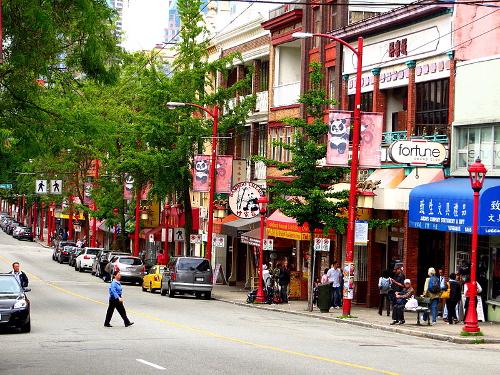 British Columbia Vancouver ChinatownPhoto: Xicotencatl CC 3.0 Unported no changes made
British Columbia Vancouver ChinatownPhoto: Xicotencatl CC 3.0 Unported no changes made
In the 20th century, many Chinese and Japanese moved to British Columbia. Although these were hard-working people, like the Europeans who kept pouring in, they were not too welcome. There were even regular violent clashes in Vancouver's Chinatown and Little Tokyo.
British Columbia went through an economically difficult period between the two world wars. During the Second World War, several German companies were destroyed, but after the war things went in the right direction. British Columbia's economy was based primarily on natural resources, and the demand for paper and timber continued to increase. The population also continued to grow throughout the twentieth century. Many immigrants came from Asia, in particular, so that British Columbia's economy became strongly linked to Asia. While things were booming in Asia in the early 1990s, British Columbia benefited, but when the Asian economy collapsed completely in the late 1990s, British Columbia's economy was also badly hit.
The first prime minister after World War II was still John Hart, but he resigned as prime minister and Treasury Secretary in December 1947. He was succeeded by Liberal party colleague Byron Ingemar 'Boss' Johnsson (actually Björn Ingimar 'Bjössi' Jónsson, 1890-1964), the 24th Prime Minister of British Columbia. Johnsson was the first Prime Minister of British Columbia born after the accession of the province of British Columbia to Canada. The Liberal-Conservative government won the 1949 elections by force majeure; with 61% the most votes ever in British Columbia history. But already in 1951 the coalition collapsed and the conservatives left the government. The subsequent 1952 elections were won by W(illiam).A(ndrew).C(ecil). Bennett's (1900-1979) Social Credit Party. Bennett would become British Columbia's longest-serving Prime Minister, from August 1, 1952 to September 15, 1972. Bennett's Social Credit Party would eventually win seven consecutive elections: 1952, 1953, 1956, 1960, 1963, 1966, and 1969. he ran for the last time, but those elections were lost.
During his long reign, during which he also served as Chancellor of the Exchequer, the first official flag of British Columbia was inaugurated in 1960. A number of nationalizations were also made, including of BC Ferries in 1960, BC Hydro in 1961 and BC Rail. In addition, many expansions and improvements of the highways, dam plants in the Columbia River and the Peace River and the establishment of the Bank of British Columbia, in which the government owned 25% of the shares. The University of Victoria was founded in 1963 and Simon Fraser University in 1965.
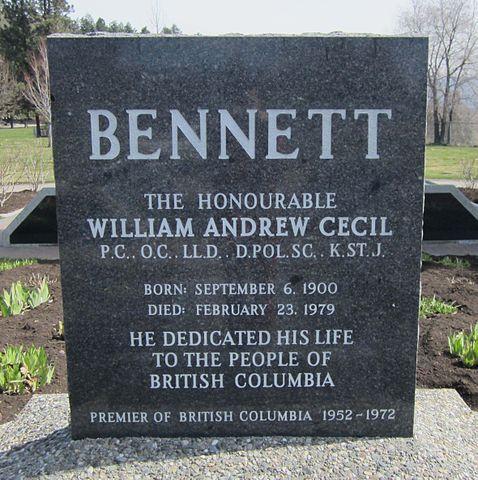 Tombstone of W.A.C. Bennett at Kelowna Memorial Park Cemetery, British ColumbiaPhoto: CurtisNaito CC 3.0 Unported no changes made
Tombstone of W.A.C. Bennett at Kelowna Memorial Park Cemetery, British ColumbiaPhoto: CurtisNaito CC 3.0 Unported no changes made
On January 9, 1965, the town of Hope in southern British Columbia was hit by the largest landslide (Hope Slide) to ever hit Canada. An earthquake caused the entire southwest slope of a mountain to slide down, burying an entire lake in the rubble. In addition, four people in a car were killed.
W.A.C. Bennett was succeeded on September 15, 1972 by David (Dave) Barrett (1930-) of the New Democratic Party of British Columbia (NDP). Under his rule, the public sector expanded and some important social reforms and measures were implemented, including the abolition of corporal punishment in schools.
Dave Barrett was succeeded in 1975 by William Richards 'Bill' Bennett (1932-2015), the son of W.A.C. Bennett. And he too, like his father, lasted for a long time, almost eleven years. Bennet won the 1975 election against Barrett for the British Columbia Social Credit Party, the new name for the Social Credit Party. He also won the elections in 1979 and 1983. His policies suffered from an economic crisis in the early 1980s, education and social services were cut sharply and labor legislation provoked a province-wide strike in 1983.
In contrast, tens of millions of dollars were invested in bringing in and organizing the Expo 86 World's Fair in Vancouver. The World's Fair was opened on May 2, 1986 by the Prince and Princess of Wales, Charles and Diana.
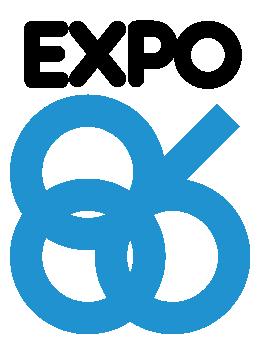 Logo of Expo 86 in Vancouver, British ColumbiaPhoto: Public domain
Logo of Expo 86 in Vancouver, British ColumbiaPhoto: Public domain
The 28th Prime Minister of British Columbia has a Dutch background. Born in Noordwijkerhout as Wilhelmus Nicholaas Theodore Marie van der Zalm (1934-), he emigrated with his parents in 1947 to Canada, in this case the Fraser Valley in British Columbia. In 1986 he succeeded the retiring Prime Minister Bennett, now as William Nicholas 'Bill' Vander Zalm. Vander Zalm was sworn in as Prime Minister of British Columbia a month before the 1986 election. Charismatic Vander Zalm's British Columbia Social Credit Party defeated the NDP with ease, though he didn't really have a long-term plan. In the end, after a number of other issues, his premiership ended due to a conflict of interest in the sale of a garden.
Vander Zalm was succeeded by British Columbia's first female Prime Minister, Deputy Prime Minister Rita Johnston (1935-), but the 1991 elections came too soon for her and the British Columbia Social Credit Party was severely punished by the voters. The party only won seven seats, and those were also the last seats the party would ever win, as the party was eventually dissolved in 2013.
The election was won by a former mayor of Vancouver, Michael 'Mike' Franklin Harcourt (1943- ), leader of the British Columbia New Democratic Party. Harcourt resigned in February 1996 for reasons of principle after a misstep ('Bingogate') by a party member, and his successor Glen David Clark (1957-) also resigned after various scandals (casinogate, fast ferry scandal). The drops were a raid on his home by the Royal Canadian Mounted Police in March 1999 and allegations in August of that year that he had taken a bribe in connection with a casino solicitation. He was later acquitted for lack of evidence, but had already resigned on August 21, 1999.
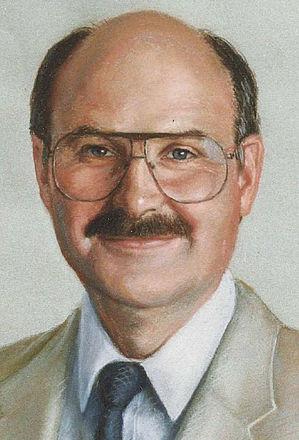 Mike Harcourt, 31st Prime Minister of British ColumbiaPhoto: Samuelgodfrey CC 3.0 Unported no changes made
Mike Harcourt, 31st Prime Minister of British ColumbiaPhoto: Samuelgodfrey CC 3.0 Unported no changes made
The NDP's interim leader and Prime Minister was Arthur Daniel Miller (1944- ), who served as British Columbia's 32nd Prime Minister until February 24, 2000. On that date, a party convention of the NDP elected Ujjal Dosanjh (1947- ) as party leader and he also became prime minister. The 2001 elections were won gloriously by the leader, since 1993, of the British Columbia Liberal Party and opposition leader Gordon Muir Campbell (1948- ), previously the 35th mayor of Vancouver. The Liberals won 77 of the 79 seats, the largest majority ever, and the number of votes was the second largest ever in British Columbia history. Gordon Campbell became the seventh Prime Minister in ten years, and the first Liberal Prime Minister in nearly 50 years.
Right at the start of his reign, he kept his promise to cut income taxes by just 25% for all taxpayers. Campbell also invested heavily in more and better education. Furthermore, the minimum wage was lowered and British Columbia (Canada) managed to bring the 2010 Winter Olympics to Vancouver.
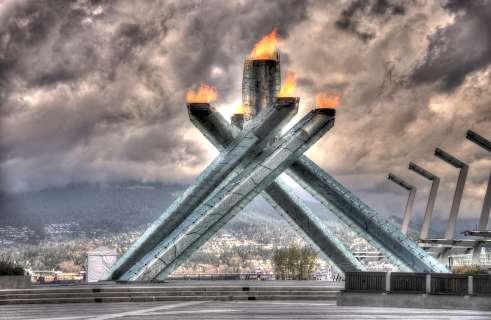 Vancouver 2010 Olympic Fire Winter Games, British ColumbiaPhoto: Duncan Rawlinson CC 2.0 Genericno changes made
Vancouver 2010 Olympic Fire Winter Games, British ColumbiaPhoto: Duncan Rawlinson CC 2.0 Genericno changes made
Campbell's Liberals also won the May 17, 2005 election, although the majority was not as strong as in 2001. The May 12, 2009 election was also somewhat less successful than in 2001, but still won a large majority of 49 seats. in a parliament that now consisted of 85 seats.
Finally, Campbell announced that he would resign on November 3, 2010, in his third reign, after months of political opposition to his plan for a tax measure called the Harmonized Sales Tax (HST). On 11 June 2010, a member of his cabinet, the Minister of Energy, Mines and Oil Stocks, even resigned because of this plan. On March 14, 2011, he effectively resigned and was succeeded by Christina Joan 'Christy' Clark (1965- ), Minister of Education under Gordon Campbell. She was also the second female prime minister and the 35th prime minister since British Columbia joined the confederation. Clark had won the February 26, 2011 leadership election (from former Health Minister Kevin Falcon with 52% of the vote) and also won the 2013 provincial election, albeit in a roundabout way because she lost the election in her own district. . The next provincial elections will be held on 9 May 2017. The elections are narrowly won by the NDP, with the help of the Green Party, John Horgan becomes the new prime minister.
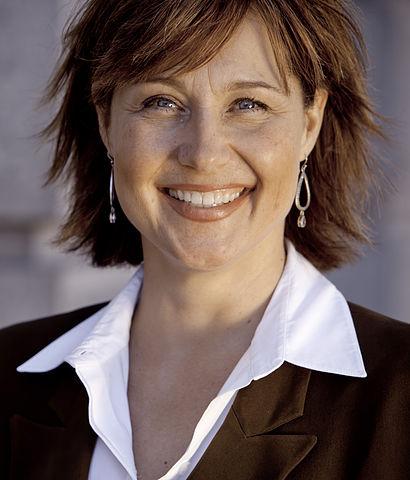 Christy Clark, 35th Prime Minister of British ColumbiaPhoto: Kris krüg CC 2.0 Generic no changes made
Christy Clark, 35th Prime Minister of British ColumbiaPhoto: Kris krüg CC 2.0 Generic no changes made
Sources
BBC - Country Profiles
British Columbia and the Rockies
Michelin Apa Publications
Canada
Cambium
Canada
Lonely Planet
CIA - World Factbook
Elmar Landeninformatie
Jepson, Tim / Vancouver en de Canadese Rockies
Wat & Hoe
Leigh Fleming, Janet / British Columbia : a walking guide
Cicerone
Ohlhoff, Kurt Jochen / Canada west & Alaska
ANWB
Phenix, Penny / Canada
Wat & Hoe
The rough guide to Canada
Rough Guides
Struijk, Aad / West-Canada
Elmar
Veldt, Marc / Canada
Gottmer/Becht
Ver Berkmoes, Ryan / British Columbia & the Yukon
Lonely Planet
Wagner, Heike / West-Canada : Alberta, British Columbia
Lannoo
Wikipedia
Last updated November 2025Copyright: Team The World of Info